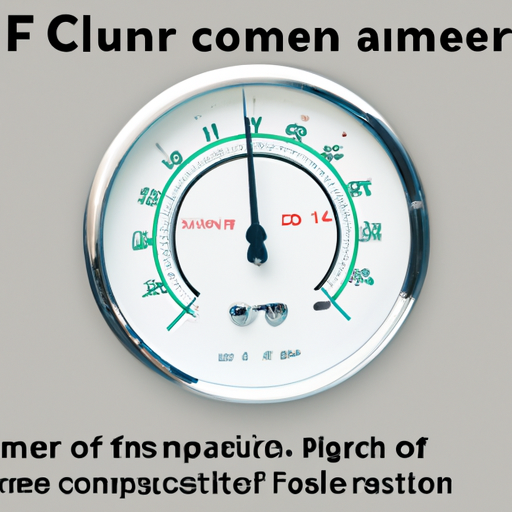When it comes to air compressors, the question often arises: is higher or lower CFM (cubic feet per minute) better? Understanding the significance of CFM in the context of air compressors is crucial for making an informed decision. In this article, we will shed light on the concept of CFM and its implications, helping you determine whether a higher or lower CFM is the right choice for your air compressor needs. So, let’s dive in and discover the answer to this age-old question!
Is Higher Or Lower CFM Better For Air Compressor
Table of Contents

Understanding CFM in Air Compressors
Air compressors are essential tools used in various industries and for a wide range of applications. One crucial factor to consider when selecting an air compressor is the CFM, which stands for cubic feet per minute. CFM measures the volume of air that an air compressor can deliver in one minute. Understanding CFM is vital to ensure optimal performance and efficiency when using air compressors.
What is CFM?
CFM refers to the amount of air that an air compressor can move or deliver in a minute. It is a crucial metric that determines the compressor’s ability to power air tools effectively. CFM is essentially a measure of airflow capacity and determines how quickly an air compressor can fill a tank or supply air to pneumatic tools.
Importance of CFM in Air Compressors
Understanding CFM is essential because it directly impacts the performance of air tools. Matching the CFM requirements of the tools to the CFM capacity of the air compressor is crucial to ensure optimal performance and prevent damage to both the tools and the compressor. Without sufficient CFM, air tools may operate below their intended performance level, leading to inefficiency and reduced productivity.
Relationship between CFM and Air Tools
CFM requirements vary depending on the type and size of air tools. Each air tool has a specific CFM requirement that is necessary for it to function optimally. It is vital to select an air compressor with a CFM capacity that can meet or exceed the tools’ requirements. Failure to do so may result in reduced tool performance, compromised efficiency, and even damage to the tools and the compressor itself.
Factors to Consider
When determining the appropriate CFM for an air compressor, several factors need to be considered. These factors include the applications and tools being used, the size of the air compressor, the desired air pressure, and the duty cycle.
Applications and Tools
Before deciding on the CFM capacity, it is crucial to understand the applications and tools that will be powered by the air compressor. Different applications and tools have varying CFM requirements. For example, a small airbrush may only require a few CFM, while a heavy-duty impact wrench may require a much higher CFM to operate effectively.
Air Compressor Size
The size of the air compressor also plays a role in determining the required CFM. Smaller air compressors generally have lower CFM capacities, while larger compressors have higher CFM capacities. It is essential to select the right-sized air compressor to ensure that it can deliver the necessary CFM for the intended applications and tools.
Air Pressure
Air pressure, measured in pounds per square inch (PSI), is another critical factor to consider when determining the CFM requirement. Different tools have specific PSI requirements, and it is important to ensure that the air compressor can deliver the required PSI along with the necessary CFM.
Duty Cycle
The duty cycle refers to the percentage of time an air compressor can operate in a given time period. Higher duty cycles allow for longer periods of continuous operation without overheating. Duty cycle needs to be considered alongside CFM capacity to ensure that the air compressor can meet the demands of the applications and tools being used.
Advantages of Higher CFM
Choosing an air compressor with a higher CFM capacity offers several advantages that make it suitable for specific situations and applications.
Increased Productivity
A higher CFM allows for faster airflow, which results in increased productivity. With more air being delivered, tools can operate at their optimal performance level, allowing tasks to be completed more efficiently and in less time. This is particularly beneficial in industries where time is of the essence, such as automotive repair shops or construction sites.
Suitable for Heavy-Duty Applications
Heavy-duty tools, such as impact wrenches or grinders, often require a higher CFM to deliver the power needed for demanding tasks. By selecting an air compressor with a higher CFM capacity, these tools can operate at their best, tackling tough applications effectively.
Accommodates Multiple Tools
In situations where multiple tools are being used simultaneously or in quick succession, a higher CFM capacity is advantageous. The increased airflow allows for the simultaneous operation of multiple tools without a significant drop in performance. This is particularly useful in workshops or construction sites where different tools are required for various tasks.
Disadvantages of Higher CFM
While a higher CFM capacity offers numerous advantages, it is essential to consider the potential downsides as well.
Higher Cost
Air compressors with higher CFM capacities tend to be more expensive than those with lower CFM capacities. The additional cost may be a deterrent for individuals or businesses with budget constraints. It is necessary to evaluate the actual CFM requirements of the tools and applications to ensure that higher CFM is truly necessary.
More Energy Consumption
Air compressors with higher CFM capacities require more energy to operate. This can lead to increased energy consumption, resulting in higher electric bills. It is crucial to assess the energy requirements and costs associated with a higher CFM capacity to make an informed decision.
Advantages of Lower CFM
In certain situations, a lower CFM capacity may be more suitable and advantageous.
Cost-Effective
Air compressors with lower CFM capacities often come at a lower price point. If the applications and tools being used do not require a higher CFM, opting for a lower CFM compressor can save money without compromising performance.
Suitable for Light-Duty Applications
Light-duty tools, such as nail guns or airbrushes, typically have lower CFM requirements. Choosing a compressor with lower CFM will still allow these tools to operate efficiently, making it a cost-effective and practical choice for light-duty applications.
Disadvantages of Lower CFM
While lower CFM capacities can be advantageous in certain situations, there are potential downsides to consider as well.
Limited Tool Compatibility
Lower CFM capacities may not meet the requirements of certain tools, especially those designed for heavy-duty applications. If a tool requires a higher CFM to function optimally, using it with a lower CFM compressor may result in reduced performance or even damage to the tool.
Reduced Performance
Tools that require a higher CFM to operate at their best may experience reduced performance when used with a lower CFM compressor. The lack of airflow may cause tools to operate at a slower speed or with less power, compromising efficiency and productivity.
Determining the CFM Requirement
To determine the appropriate CFM requirement for an air compressor, it is crucial to understand the specific application and tools being used.
Understanding Your Application
Start by identifying the primary application or applications for which the air compressor will be used. Determine the tools that will be powered by the compressor and their individual CFM requirements. This will provide a clearer picture of the total CFM needed.
Calculating CFM Requirements
To calculate the total CFM requirement, add up the CFM requirements of all the tools that will be used simultaneously or within a short time frame. It is crucial to consider the peak CFM requirements and the duty cycle of the tools.
By accurately calculating the CFM requirements, you can select an air compressor that meets the demands of your specific applications and tools.
Importance of Proper CFM Matching
Matching the CFM capacity of an air compressor to the requirements of the tools being used is of utmost importance. The proper CFM matching ensures optimal performance and efficiency while preventing damage to both the tools and the compressor.
Balancing CFM and PSI
When selecting an air compressor, it is essential to consider both CFM and PSI requirements. CFM provides the necessary volume of air, while PSI delivers the required pressure. Matching the CFM and PSI values ensures that the air compressor can supply the right amount of air at the correct pressure for the tools being used.
Ensuring Optimal Tool Performance
By selecting an air compressor that matches the CFM requirements of the tools, you can ensure they operate at their optimal performance level. Tools that receive insufficient airflow may underperform or fail to function altogether. Proper CFM matching allows tools to deliver the power and performance they were designed for.
Avoiding Damage to Tools and Compressor
Using tools with a higher CFM requirement than the compressor’s capacity can strain both the tools and the compressor. The lack of sufficient airflow can cause tools to overheat or operate at lower power, potentially damaging their internal components. Additionally, the compressor may experience increased wear and tear and a reduced service life. Proper CFM matching prevents such issues and extends the longevity of both the tools and the compressor.
Considerations for Small Workspaces
For those working in small workspaces, there are additional factors to consider when selecting an air compressor.
Noise and Size
In compact workspaces, reducing noise levels and saving space are often priorities. It is beneficial to choose an air compressor that operates quietly to minimize disruptions in the workspace. Additionally, selecting a smaller-sized compressor that can fit comfortably in limited spaces can enhance efficiency and optimize workspace layout.
Portable Options
Portability can be crucial in small workspaces or when working on various job sites. Consider selecting a portable air compressor that can be easily moved around to accommodate different work areas. Portable compressors often have lower CFM capacities, making them suitable for light-duty applications in smaller workspaces.
Tank Size
The tank size of an air compressor also plays a role in small workspaces. A smaller tank size can save space but may require more frequent refilling. Consider the specific application needs and desired operating time when selecting a tank size that strikes the right balance in a small workspace.
Conclusion
When it comes to selecting the right air compressor, understanding CFM is essential. Whether higher or lower CFM is better largely depends on the specific applications and tools being used. Higher CFM capacities offer increased productivity, suitability for heavy-duty applications, and the ability to accommodate multiple tools. However, they come with higher costs and energy consumption. On the other hand, lower CFM capacities are cost-effective and suitable for light-duty applications but may have limited tool compatibility and reduced performance.
Determining the CFM requirement involves understanding the applications and tools, calculating the necessary CFM, and matching the CFM and PSI values. Proper CFM matching ensures optimal tool performance, avoids damage to tools and the compressor, and promotes efficient and safe operation. For those working in small workspaces, considerations such as noise and size, portability, and tank size become important factors to address.
By taking into account these factors and understanding the specific needs of the applications and tools, one can make an informed decision when selecting an air compressor. Choosing the right CFM capacity will not only enhance productivity and efficiency but also extend the lifespan of tools and the air compressor itself.


